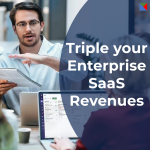
The Unseen Architects of Revenue Growth
Why Your Next Sales Leader Might Be an Algorithm or an Outsider
The business world is a complex tapestry, constantly reweaving itself in response to new technologies, shifting customer behaviors, and relentless competition. For C-suite executives, especially those steering B2B SaaS, tech, and media companies, navigating this landscape feels less like a steady voyage and more like a bewildering journey through a dense fog. The very strategies that once promised clear passage now seem to lead to unexpected stalemates—and the traditional playbook for Go-to-Market transformation appears increasingly obsolete.
The Paradox of Success: When Winning Formulas Stop Working
Consider Valiant Systems (company name anonymized), once the undisputed titan of B2B SaaS solutions for media companies. Their content management platform was lauded by industry analysts, their sales leadership team was a roster of highly compensated veterans poached from Fortune 500 companies, and their market share in the entertainment sector seemed impenetrable. They had everything a textbook would prescribe for sustained growth: premium pricing, established client relationships, and a Go-to-Market strategy that had delivered double-digit revenue increases for three consecutive years.
Yet, despite all the indicators of success, an unsettling phenomenon began to unfold: growth inexplicably stalled. New customer acquisition among streaming services and production companies dwindled, and, more alarmingly, churn among their most valuable media clients started to tick upwards. Their once-reliable internal data, instead of providing clarity, became a confusing jumble of contradictions. The C-suite was baffled, convinced they were “doing everything right” by historical benchmarks, but the market simply wasn’t responding as it used to.
Investments poured into conventional sales training, enhanced marketing campaigns targeting entertainment executives, and even premium booths at major industry conferences. Yet the needle barely moved. Internally, once cohesive teams started pointing fingers, trapped in what experts call a “broken puzzle approach”—where each department optimized its own metrics while the overall Go-to-Market engine sputtered, fostering frustration and a retreat to old, increasingly ineffective methods.
The Hidden Question Behind Market Disruption
Why do companies like Valiant Systems, armed with cutting-edge products and substantial investments in traditional sales and marketing, find themselves struggling to capture value in today’s dynamic B2B landscape? What if the very notion of a static, in-house sales leader, or a Go-to-Market strategy built on yesterday’s assumptions, is precisely what’s holding back the next wave of exponential revenue growth?
Here’s the counterintuitive puzzle: What if the key to unlocking sustainable market dominance isn’t found by simply doing more of the same—hiring more sales executives, increasing marketing spend, or doubling down on existing channels—but by radically re-imagining who leads your sales transformation and how your entire GTM strategy is architected, managed, and continuously evolved?
Unraveling the Modern GTM Mystery: What the Data Reveals
The profound transformation reshaping the B2B market is undeniable, driven by seismic shifts that have fundamentally altered how business buyers make decisions. Modern B2B buyers—whether they’re CTOs at streaming platforms or procurement directors at media conglomerates—now demand a dual experience: deep technical expertise paired with simplified, self-service interactions that mirror their consumer purchasing habits.
These buyers are more digitally sophisticated than ever, making faster decisions with smaller committees, and their focus has shifted beyond mere IT feature comparisons to measurable business outcomes. They want to understand not just what your solution does, but how it will demonstrably impact their bottom line, operational efficiency, or competitive positioning. The customer journey itself is no longer linear, demanding that GTM strategies reflect this modern, serpentine path from initial awareness through channel selection to measurable ROI.
Yet most organizations continue to deploy traditional GTM models that are proving increasingly inadequate. Research across the B2B SaaS, tech, and media sectors reveals several critical failure points:
The Flexibility Trap: Legacy GTM frameworks are too rigid to adapt rapidly to new market entrants, shifting buyer preferences, or emerging competitive threats. When TikTok disrupted traditional media consumption patterns, companies with inflexible Go-to-Market strategies struggled to pivot their messaging and channel strategies quickly enough to capture new opportunities.
The Data Paradox: Despite having access to more customer data than ever before, many organizations still make crucial GTM decisions based on intuition, anecdotal feedback, or outdated market research rather than real-time, actionable insights derived from their own customer interactions and market signals.
The Collaboration Crisis: A pervasive lack of cross-functional collaboration leads to siloed efforts and fundamentally misaligned goals. Sales teams optimize for short-term deal closure, marketing focuses on lead generation metrics, and customer success measures retention—but rarely do these functions operate as a unified revenue engine with shared accountability.
The cost of this misalignment is staggering. Studies indicate that sales and marketing disconnects alone can lead to revenue declines of 10-20% and missed growth opportunities that, across the technology sector, potentially cost organizations hundreds of billions in unrealized potential. Research from leading business schools shows that up to 70% of GTM transformation initiatives falter precisely due to inadequate leadership alignment and internal resistance to new methodologies.
Meanwhile, companies that have successfully embraced Go-to-Market transformation report remarkable results. Artificial Intelligence is revolutionizing GTM capabilities by enabling real-time market analysis, dynamic customer segmentation, predictive modeling for deal probability, personalized content generation at scale, and automated customer interactions that maintain the human touch. Organizations employing AI-driven GTM strategies have reported revenue improvements ranging from 3% to 15% and sales ROI enhancements from 10% to 20%.
However, AI implementation is a double-edged sword. Successfully integrating artificial intelligence into Go-to-Market strategies involves significant internal hurdles: complex ROI evaluation, substantial upfront costs, integration challenges with existing CRM and marketing automation systems, and the critical need to ensure scalability across different market segments. Many companies attempt to force new AI-driven insights into old organizational frameworks, leading to frustration and the premature abandonment of potentially transformative initiatives.
The Breakthrough: Rethinking Revenue Leadership
The most profound transformation in Go-to-Market strategies for B2B SaaS, tech, and media companies isn’t just about what new tools you adopt, but who you empower to lead the transformation and how you architect the entire revenue generation system.
Here’s the counterintuitive revelation: Sustainable, explosive revenue growth in today’s unpredictable market is increasingly driven not by a permanent, traditional sales executive, but by agile, data-driven revenue architects—often fractional leaders or specialized external consultants—who continuously recalibrate the entire GTM engine based on real-time market feedback.
This represents a fundamental shift from viewing sales leadership as a static organizational role to embracing it as a dynamic, continuously optimized function. Instead of “hiring a VP of Sales,” forward-thinking companies are adopting a “growth-as-a-service” mindset where strategic insight, tactical execution, and leadership development are continuously injected and optimized rather than treated as fixed organizational assets.
This approach transforms revenue generation from a departmental responsibility into an organizational imperative, where every function—from product development to customer success—is aligned around measurable contribution to sustainable growth.
The Strategic Implications: What This Means for Your Business
This unconventional approach translates directly into measurable business outcomes, fundamentally moving beyond a static “Go-to-Market plan” to embrace “Go-to-Market as a Service”—a dynamic, continuously evolving system.
Agile Strategy & Execution: Success stems from intelligently blending AI-driven insights with human strategic thinking, creating a flexible approach that adapts in real-time to market dynamics. This methodology fosters immediate revenue acceleration while building the foundation for sustainable, long-term profitability. A “growth-as-a-service” model, often delivered through specialized revenue growth management consulting, ensures continuous optimization based on market feedback, competitive intelligence, and iterative strategy refinement.
Unified Revenue Operations: Breaking down traditional silos between sales, marketing, and customer success creates a single source of truth for all customer data and interactions. This unification promotes genuine cross-functional collaboration and aligns teams around consistent KPIs that matter for overall business growth. This isn’t merely about implementing shared technology platforms; it’s about fostering a common culture focused on customer lifetime value and sustainable revenue growth.
Reimagined Sales Leadership & Talent: Traditional account managers focused solely on relationship management are no longer sufficient. Success demands “transformation-led sales professionals” with deep solution knowledge, industry expertise, and the ability to consultatively guide prospects through complex buying decisions. This often necessitates completely redefining seller talent profiles and developing new competencies around business outcomes rather than product features.
Fractional sales leadership can rapidly infuse these new capabilities, offering immediate, high-impact guidance to align sales, marketing, and customer success motions. These external leaders provide “embedded leadership and coaching,” acting as senior advisors who integrate directly with internal teams to guide execution while fostering a culture of rapid experimentation and continuous improvement.
Customer-Centricity as a Growth Engine: Moving beyond traditional departmental boundaries—such as integrating customer success insights directly into marketing strategy—provides a comprehensive view of client perceptions and enables the development of retention and expansion strategies that drive long-term client value. Investing in comprehensive customer research, feedback mechanisms, and predictive analytics enables organizations to tailor products, services, and experiences to precisely address customer pain points, driving both immediate sales acceleration and long-term loyalty.
Specifically for SaaS, Tech, Media and Entertainment Companies:
These transformation principles are particularly relevant for SaaS, Tech, media and entertainment organizations facing rapidly shifting consumption patterns, increasingly diverse audience preferences, and a hyper-fragmented content landscape. Just as other industries must evolve their GTM strategies to address changing customer behaviors, media companies must reimagine their audience engagement approaches to reach consumers across streaming platforms, social media channels, gaming environments, and emerging interactive experiences.
The customer value framework becomes critical for media executives who must define what value means for different audience segments across various content types and distribution platforms. Success requires granular market analysis and persona-driven strategies meticulously tailored to specific demographic behaviors, regional preferences, and consumption patterns. Distribution channels must reflect local market nuances—whether through specific regional streaming services, traditional broadcast partnerships, or community-based experiential events.
The Choice: Architect or Passenger?
The era of rigid, departmentalized Go-to-Market strategies is rapidly ending. The most successful B2B SaaS, tech, and media companies of tomorrow won’t simply be those with the best products or the largest sales teams, but those with the most adaptable, data-fluent revenue growth engines—guided by strategic insights and powered by flexible, results-driven leadership.
The true competitive advantage lies in embracing “growth-as-a-service,” where expert guidance and fractional leadership act as catalysts, transforming market volatility from a threat into an unparalleled opportunity for accelerated revenue growth and enhanced enterprise value.
The fundamental question for every C-suite executive becomes: Are you simply managing your current business operations, or are you actively architecting your organization’s next era of sustainable growth? The leadership, methodologies, and strategic frameworks for this transformation are not just available—they’re waiting to be activated. The only question remaining is whether you’ll choose to be the architect of your revenue future or remain a passenger hoping that traditional approaches will somehow deliver extraordinary results in an extraordinary market.
To learn more contact us at ngulam.com.






